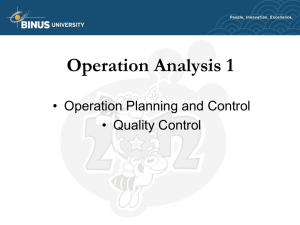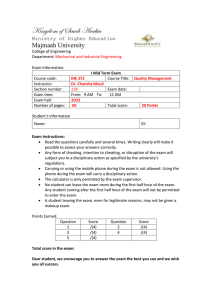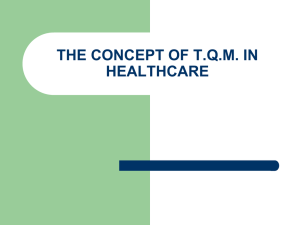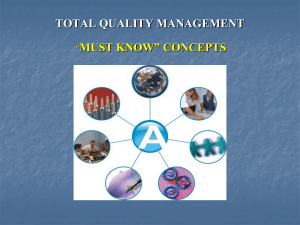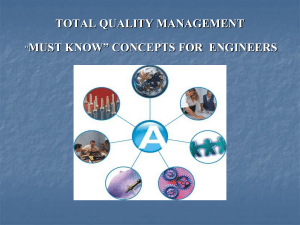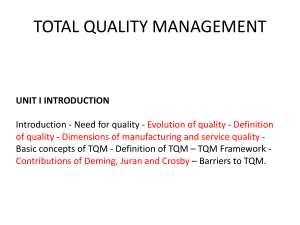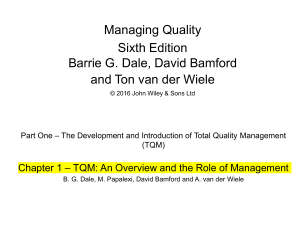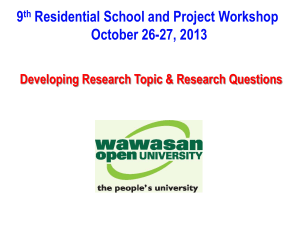Quality Management: TQM, Dimensions, Improvement, Planning
advertisement
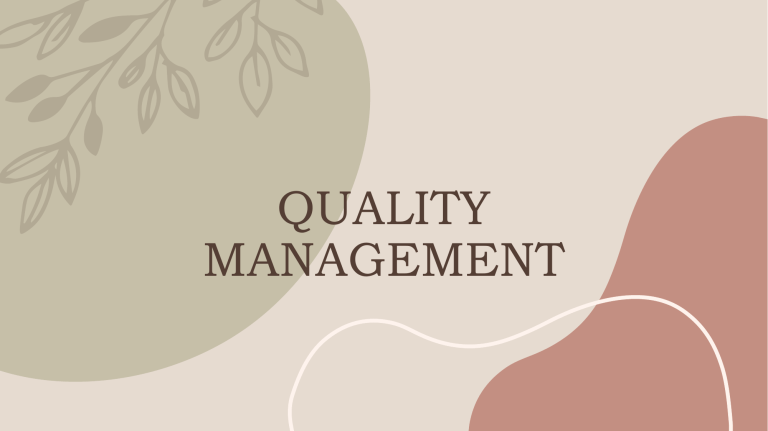
QUALITY MANAGEMENT What is Quality Management? Quality management oversees all activities and tasks that must be accomplished to maintain a desired level of excellence. 2 THE EVOLUTION OF TOTAL QUALITY MANAGEMENT (TQM) The concept of quality has existed for many years, though its meaning has changed and evolved over time. In the early twentieth century, quality management meant inspecting products to ensure that they met specifications. In the 1940s, during World War II, quality became more statistical in nature. Quality began to be viewed as something that encompassed the entire organization, not only the production process. Since all functions were responsible for product quality and all shared the costs of poor quality, quality was seen as a concept that affected the entire organization. DIMENSIONS OF QUALITY 1. Performance a performance characteristic describes a product's essential function. 2. Features are a secondary aspect of performance. They're "the bells and whistles" of products and services. They're the ones who add extra functionality to their essential functions. 3.Reliability is the ability of a product or service to perform as expected over time. 4.Conformance is the degree to which a product conforms to its specification. 6 5. Durability is the measurement of product life. This defines the amount of use the customer could get from the product before it deteriorates. 6. Serviceability is the ease at which a user can repair a faulty product or get it fixed. 7. Aesthetics refers to the appearance of a product or service. 8. Perceived Quality is the overall opinion of the customers towards the product. 7 5 service quality dimensions • Tangibility is the appearance of physical facilities, equipment, personnel, and communication materials. • Reliability is the ability to perform the promised service dependably and accurately. • Responsiveness is the willingness to help customers and provide prompt service. • Assurance is the knowledge and courtesy of employees and their ability to convey trust and confidence. • Empathy is the caring, individualized attention the firm provides its customers. 8 Quality Improvement • Quality improvement is a structured approach to evaluating the performance of systems and processes, then determining needed improvements in both functional and operational areas What Is the Main Purpose of Quality Improvement? • Quality improvement aims to create efficiencies and address the needs of customers. In healthcare, the main purpose of quality improvement is to improve outcomes. 9 Benefits of a Quality Improvement Process A quality improvement process can offer organizations the following benefits: • Solutions that focus on failures in processes, not flaws in people • A reliance on objective, data-driven solutions, rather than subjective opinions, to identify inefficiencies, preventable errors, and inadequate processes • Improvements that provide better customer service, increased efficiency, greater safety, and higher revenues 10 • A localized focus on testing small, incremental improvements that are less risky than a focus on making changes at one time • Data collection to monitor improvement efforts, which can provide the basis for reimbursement and certification programs, particularly in healthcare organizations 11 QUALITY PLANNING • A quality plan illustrates how an organization will attain it’s quality objectives. • Quality planning is the formation of an actionable plan that defines and guarantees quality from idea to delivery. 12 By planning the quality one has to respect some principles: • Customer satisfaction comes first- Quality is identified by the requirements of the customer. • Prevention over inspection- It is better to keep away from errors than to check the end result and patch up the defects. • Management responsibility- Costs of quality must be permitted by the management. • Continuous improvement- Becoming improved is an iteratively structured process. 13 QUALITY PLANNING TOOLS • Cost benefit analysis is a technique to find out whether the desired quality standards can or should be payed. • Benchmarking may be considered as the process of evaluating the real project to other projects for producing ideas for improvement and offering a foundation by which to measure performance. • Plan of experiments is a technique for examining the influence of single parameters on the degree of quality of the entire product/process 14 • Cost of quality are the total costs incurred by investment in preventing nonconformance to requirements, appraise the product or service for conformance to requirements, and failing to meet requirements. • Additional quality planning tools may support the quality planning process. Such tools and techniques are brainstorming, affinity diagrams, force field analysis, nominal group techniques, matrix diagrams, flowcharts, and prioritization matrices. 15 QUIZ 1.) What is TQM? 2 points. 2.) Give atleast 4 dimensions of quality? 2 points each. 3.) What is the main purpose of quality improvement? 5 points. 4.) Enumerate the 5 service quality dimensions 16 thank you GROUP 1 Erwin Sumodobila Leandro Tagbac Adrian Lee Tabañera Edralie Jan Valencia
